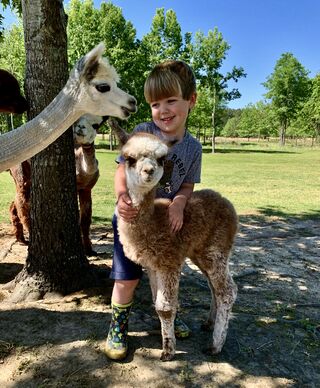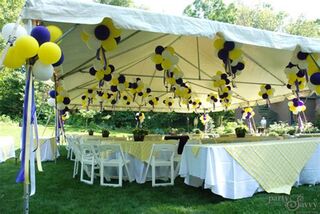Alpaca Fencing
What's all the Fuss About....
A couple of disclaimers before I begin:
1. I live in a SW Michigan on (10) Acres of land
2. We have a Golden Retriever as a "lick your hand" guard dog
3. We most definitely have coyotes, I see them every other day and here them every night.
4. Alpacas do not challenge fencing. This I absolutely agree with, barbed wire/electric wire is not necessary and can actually cause more problems then they are worth.
What I have heard:
1. (5) foot high no climb fence is a must to keep white tail deer (which we have a ton of in our area) out of your pastures and paddocks. If you don't your pastures will will be harbor the M-worm and your alpacas will get sick.
2. (6) foot high would be even better and line the perimeter of your pastures with limestone to keep out snails and slugs which carry the M-worm on their slim pad into your pastures.
What I have seen:
Stretched No Climb Fencing (see photo to the right)
I mean, don't get me wrong it looks very nice and had to have cost a pretty penny.
White tail deer can still clear this type of fence in one bound. Giving them a quick shot of Ivermectin (De-Wormer and Trump Cure for Covid-19!) every 30 days is way cheaper on the wallet.
What we have:
(4) strand high tensile galvanized wire available from TSC / Blaine's / almost all farm stores. Very cost effective. Note: Added a 5th wire later, see comment below.
Distance Between Posts: Between line posts: (20) feet. I was told (10) by a hobby cattle farmer. I went with (20) and saved some real bucks doing so, seems to have worked for my needs. However, I did and a (5)th Wire where we keep our newborn Cria's. We did have one little escape artist that got very good at sliding under the 4th wire. The 5th wire took care of this issue and kept him in where he was suppose to stay. As he grew to over 110 lbs he also stopped this behavior.
Another consideration is your guard dog. As mentioned we have a golden retriever, and I wanted to make sure he had free roaming access to all the paddocks and areas or our property. I can't tell you what a blessing it is to have him on the property. He keeps all the raccoons possums and coyotes at bay. Since moving to this property we have not had an issue with rodents of this type. For the smaller variety we keep two field cats around to dispatch mice, chipmunks and squirrels.
Between corners and brace posts: should be a minimum of (6) feet. This is a must. You want to have as long a horizontal member as possible to stabilize the corner "King Post". Take a drive around and look at some old farm fencing. Even newer larger farms will replace this wooded "horizontal post" with a length of galvanized pipe. This has no give to it and makes for a rock solid corner. Remember that with high tensile galvanized wire you will need a very strong corner to be able to pull the wire tight. I had to go around and fix my corners after I had the wire strung as the corners kept pulling-over, which is why I highly recommend you cement them in. Remember to set your corners first in concrete or expanding foam, it will save you tons of headaches later. Also, if you decide against concreating the King Posts. Lean them away from the stretch by 2". This will allow them to be perfectly vertical when you ratchet the high tensile line tight. TSC also
Gates:
Plan, plan, plan. You will want a lot of them. It makes living and working around your animals that much more enjoyable. Make sure you leave enough room to get tractors and trucks through as well as just simple people gates which allow you to move through the fencing to the other side to clear debris or fix fencing. Additionally, We have put up a couple of "Drive-Thru" Gates. These allow you to get through fencing without having to get out of your vehicle and open and close gates. This becomes very handy during winter feedings.
Water:
As soon as you can afford it, put in a no freeze underground water system. Automatic livestock waters and freeze proof spickets. Even if you don't plan to put a livestock watering station in for a while, run the water line to that location anyway. It will be there for you when your ready. Also, don't forget to drop in some electric underground power in the same trench you opened up to lay in the poly water pipe. Separate the two with a layer of dirt and then cover the entire trench back up. You will thank yourself later for this little convivence.
What I am most concerned with:
1. Domesticated dog(s) that get lose without his owners knowledge. However, That is why we keep Curt ( Our Golden Retriever) around.
2. Male Alpaca's will stand on fencing as a method of elevating their bodies and heads to get a better look at female alpacas. It is best to try and keep their pens and paddocks out of the line of sight of the females. Their desire to get next to the ladies can lead to them inadvertently pulling a fence line down.
3. New born Alpacas can most definitely roll under the fence, this is a problem until they get to 110lbs then they no longer can get under the fence. I built a cria crib to keep them in until they got to be 110lbs. Latter, I added that 5th strand of wire mentioned above. I didn't like the look of no climb fence as you could not see through it as well. We want to be able to look out over our property to see if any of the animals are having any problems, or just to watch them. You will want to keep them upfront and close to the house anyway during this time just to keep an eye on them until you know all is well.
4. I have only witnessed an Alpaca crashing through this (4) strand fence once when the fence was loose and we had a female separated from the rest of the herd. Her desire to get back to the herd was just that strong! After she was reunited with her herd mates we had no other issue.
May 20, 2023




